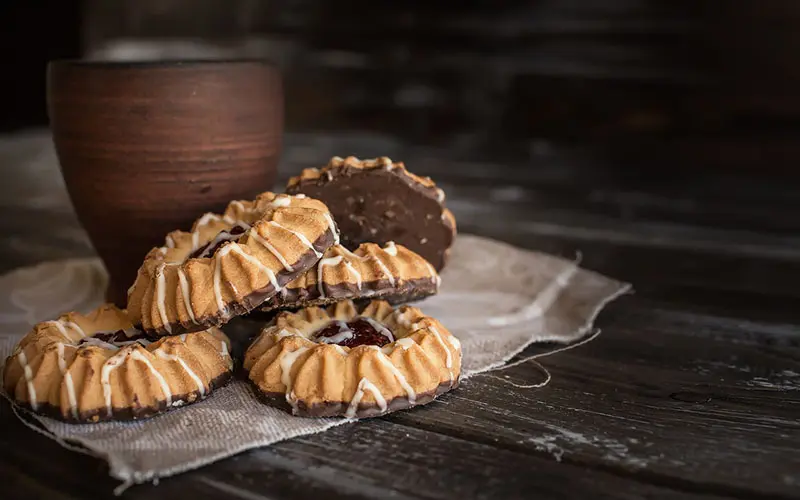If you’ve recently moved from a lower elevation to a higher one, and you can’t figure out why your baking isn’t what it used to be, you’re not alone. Countless home bakers have found themselves facing the same conundrum where grandma’s tried-and-true gourmet chocolate chip cookies suddenly are spreading all over the cookie sheet, and homemade bread is burnt on the outside and raw in the middle. That’s not even mentioning the sympathy gift or thinking of you gift that you made only to throw away the tough, flattened, or charred results.

(jyliagorbacheva / pixabay)
Moving to a high altitude definitely poses challenges for people who love to bake, but unfortunately, there isn’t a simple solution. Even though there are some guidelines you can follow to adjust your favorite recipes, most of your efforts will be trial and error. To get you started, though, here are some general modifications you can try to combat common high-altitude cookie problems:
Problem: Cookies Don’t Taste As Good
Probably the most insulting problem resulting from high-altitude baking is knowing that your cookies don’t taste as good as they used to. And why is that? One big reason is that high-altitude environments tend to be significantly drier than low-altitude environments. Without all of the extra moisture in the air to grab onto your cookies’ smells and transport them into your nose, things just don’t smell or taste as good as they used to.
To counteract this unfortunate side effect of high-altitude life, you need to pay particular attention to the flavors you use in your recipes. Start by using top-notch ingredients, and then fiddle a little with your measurements. Many high-altitude cookie recipes can do with a little extra vanilla or a stronger variety. With chocolate cookies, using Dutch-process cocoa or supplementing the chocolate flavor with espresso powder is a super way to boost the overall chocolate flavor. Experimenting with other extracts can also yield a better-tasting cookie.
Problem: Spreading
Another frustrating problem that high-altitude bakers run into is excessive spreading. When cookies spread too much or too quickly, they get crunchy, which might be a good thing if you like your cookies crispy, but let’s face it: some cookies are better off soft and chewy. The reason behind the spreading is complicated because it has to do with how the sugars, leavening agents, and fats interact, so we will spare you the specifics.
One of the most common ways to combat spreading is to raise your oven temperature 15-25 degrees Fahrenheit and reduce the bake time by about 5 minutes. Doing this will help your cookies develop a quick crust that will determine the final shape of the cookie. Another way to prevent spreading is to reduce the amount of sugar by about a tablespoon per cup.
Problem: Crumbly or Dry
At higher altitudes, water evaporates at a lower temperature, which means your cookies can get dry and crumbly very easily. If you find that’s the case, you might want to add one or two extra tablespoons of water if you live at 3,000 feet about sea level. You can add another tablespoon for every 2,000 additional feet you live, or you might even find success adding an extra egg if you live at a really high altitude. Adding another tablespoon of flour for every 3,000 feet you live above sea level can also strengthen the structure of your cookies and prevent them from falling apart.
Problem: Over/Under Baked
You don’t find this problem so much with cookies as you do with bars, cakes, or breads, but you still might encounter it with cookie recipes that use a lot of leavening, such as baking soda or baking powder. In high-altitude environments, baking soda and baking powder meet less resistance from the air, so they tend to rise really quickly and then fall. To counteract this issue, you can decrease the leavening agent by about 1/8 teaspoon per teaspoon of soda or powder. Having less leavening agent means a slower, more consistent rise that will result in evenly-baked cookies.
Problem: Cookies Get Stale
After all of your hard work making delicious cookies, you might find that they go stale days before they used to. This also has to do with the amount of moisture in the air (or lack of it), so you just need to be conscious of that when you store your cookies. You should keep your cookies in an airtight container or bag as soon as they have cooled to room temperature. Additionally, you can sometimes get away with sticking a slice of bread in with your cookies, and that will keep things softer for longer.
Even with all of this advice, there is no single solution to the problems you will run into with high-altitude baking. A good rule of thumb is to write down what modifications you try and the results, so your future experimentation can fine-tune the process. If you don’t have time to try, try again, you can always send some of our fresh baked cookies in the mail or find a recipe specifically designed for high-altitude kitchens.
